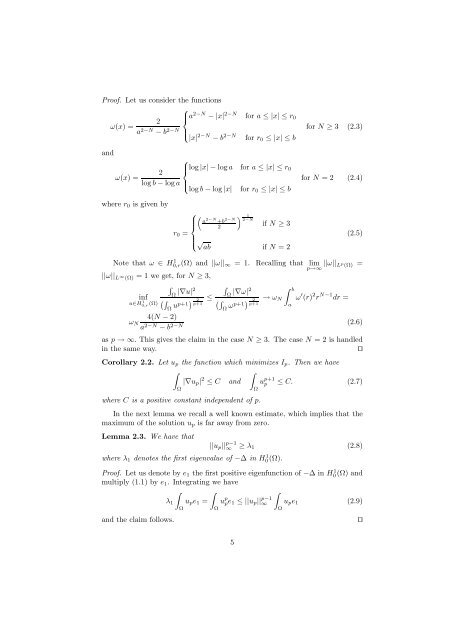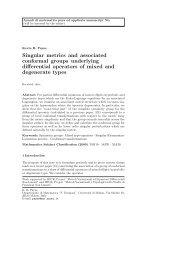Asymptotic behaviour of the Kazdan-Warner solution in the annulus ∗
Asymptotic behaviour of the Kazdan-Warner solution in the annulus ∗
Asymptotic behaviour of the Kazdan-Warner solution in the annulus ∗
Create successful ePaper yourself
Turn your PDF publications into a flip-book with our unique Google optimized e-Paper software.
Pro<strong>of</strong>. Let us consider <strong>the</strong> functions<br />
2<br />
ω(x) =<br />
a2−N − b2−N ⎧<br />
⎪⎨<br />
⎪⎩<br />
a 2−N − |x| 2−N for a ≤ |x| ≤ r0<br />
|x| 2−N − b 2−N for r0 ≤ |x| ≤ b<br />
and<br />
⎧<br />
⎪⎨ log |x| − log a for a ≤ |x| ≤ r0<br />
2<br />
ω(x) =<br />
log b − log a ⎪⎩<br />
log b − log |x| for r0 ≤ |x| ≤ b<br />
where r0 is given by<br />
⎧<br />
1<br />
2−N 2−N 2−N<br />
⎪⎨<br />
a +b<br />
2 if N ≥ 3<br />
r0 =<br />
⎪⎩ √<br />
ab if N = 2<br />
for N ≥ 3 (2.3)<br />
for N = 2 (2.4)<br />
(2.5)<br />
Note that ω ∈ H1 0,r(Ω) and ||ω||∞ = 1. Recall<strong>in</strong>g that lim<br />
p→∞ ||ω|| Lp (Ω) =<br />
||ω|| L∞ (Ω) = 1 we get, for N ≥ 3,<br />
<br />
<br />
b<br />
<strong>in</strong>f<br />
u∈H 1 0,r (Ω)<br />
<br />
Ω<br />
4(N − 2)<br />
Ω |∇u|2<br />
ωN<br />
a2−N − b2−N up+1 2<br />
p+1<br />
Ω ≤<br />
|∇ω|2<br />
<br />
Ω<br />
ωp+1 2<br />
p+1<br />
→ ωN<br />
a<br />
ω ′ (r) 2 r N−1 dr =<br />
(2.6)<br />
as p → ∞. This gives <strong>the</strong> claim <strong>in</strong> <strong>the</strong> case N ≥ 3. The case N = 2 is handled<br />
<strong>in</strong> <strong>the</strong> same way. ⊓⊔<br />
Corollary 2.2. Let up <strong>the</strong> function which m<strong>in</strong>imizes Ip. Then we have<br />
<br />
|∇up| 2 <br />
≤ C and ≤ C. (2.7)<br />
Ω<br />
where C is a positive constant <strong>in</strong>dependent <strong>of</strong> p.<br />
Ω<br />
u p+1<br />
p<br />
In <strong>the</strong> next lemma we recall a well known estimate, which implies that <strong>the</strong><br />
maximum <strong>of</strong> <strong>the</strong> <strong>solution</strong> up is far away from zero.<br />
Lemma 2.3. We have that<br />
where λ1 denotes <strong>the</strong> first eigenvalue <strong>of</strong> −∆ <strong>in</strong> H 1 0 (Ω).<br />
||up|| p−1<br />
∞ ≥ λ1 (2.8)<br />
Pro<strong>of</strong>. Let us denote by e1 <strong>the</strong> first positive eigenfunction <strong>of</strong> −∆ <strong>in</strong> H1 0(Ω) and<br />
multiply (1.1) by e1. Integrat<strong>in</strong>g we have<br />
<br />
<br />
(2.9)<br />
λ1<br />
upe1 =<br />
Ω<br />
Ω<br />
u p pe1 ≤ ||up|| p−1<br />
∞<br />
upe1<br />
Ω<br />
and <strong>the</strong> claim follows. ⊓⊔<br />
5








